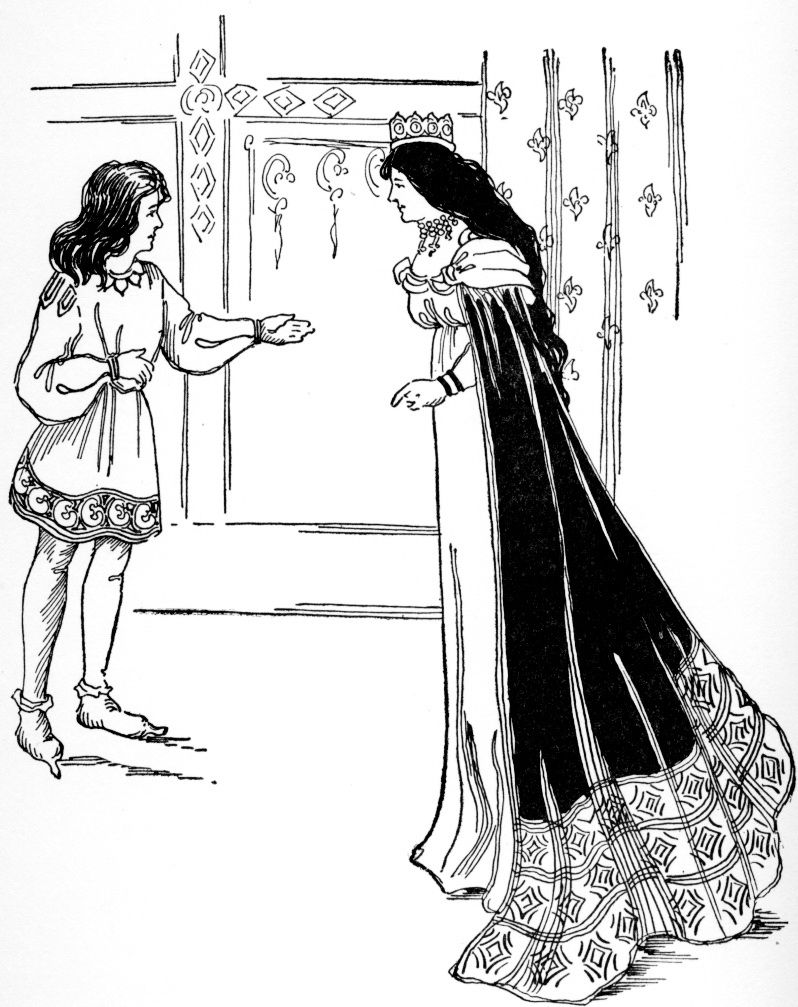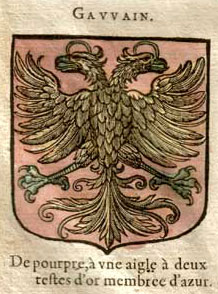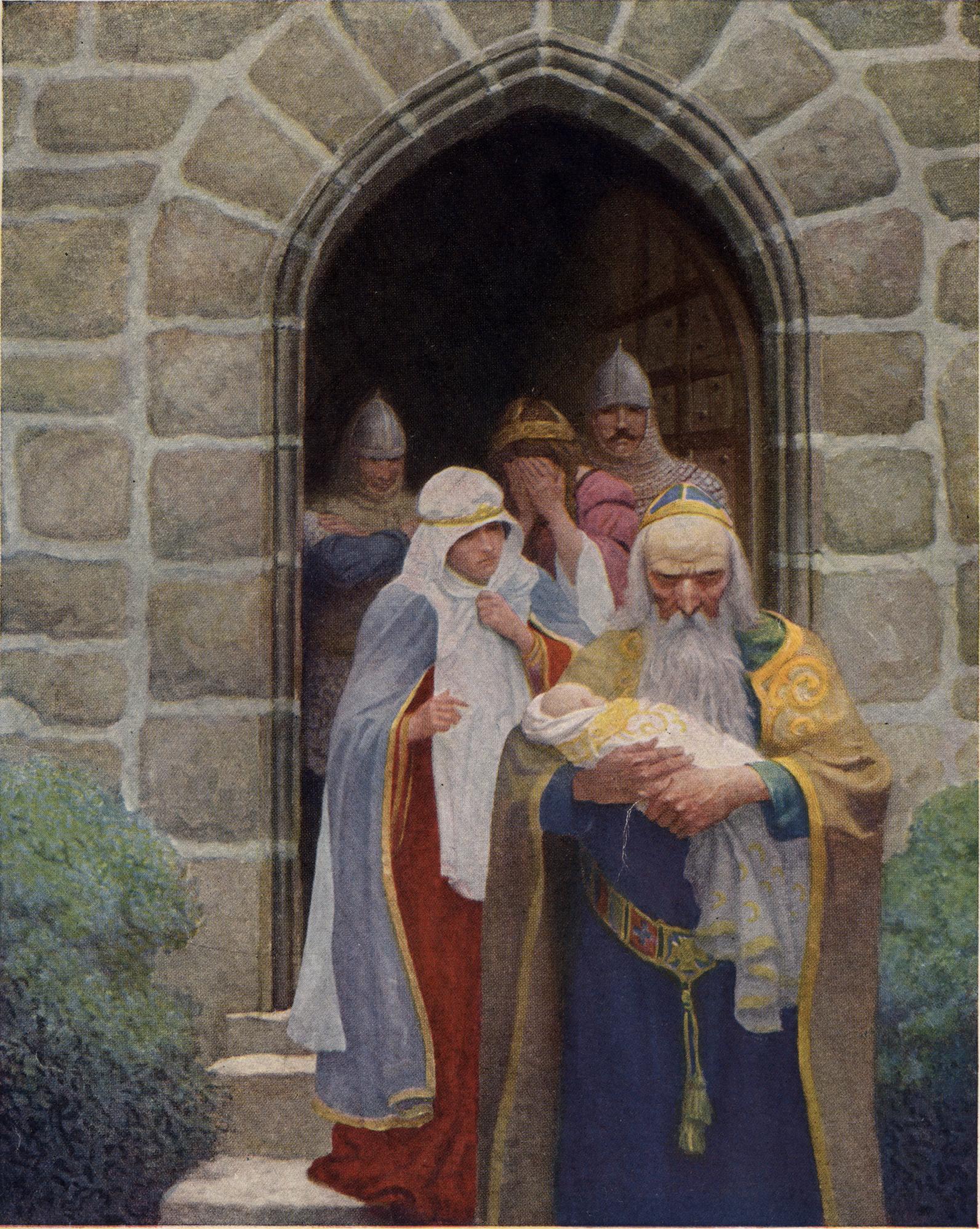|
Morgause
The Queen of Orkney, today best known as Morgause and also known as Morgawse and other spellings and names, is a character in later Arthurian traditions. In some versions of the legend, including the seminal text ''Le Morte d'Arthur'', she is the mother of Gawain and Mordred, both key players in the story of King Arthur and his downfall. Mordred is the offspring of Arthur's accidental incest with Morgause, the king's estranged half-sister. She is furthermore a sister of Morgan le Fay and the wife of King Lot of Orkney, as well as the mother of Gareth, Agravain, and Gaheris, the last of whom murders her. Earlier counterparts The corresponding character of Arthur's sister in Geoffrey of Monmouth's 12th-century Latin chronicle '' Historia Regum Britanniae'' is named Anna, and is depicted as a daughter of Uther Pendragon and Igraine. In Wolfram von Eschenbach's '' Parzival'', Anna is replaced by Sangive, whom the poet Der Pleier calls Seife. They are usually cast in th ... [...More Info...] [...Related Items...] OR: [Wikipedia] [Google] [Baidu] |
Mordred
Mordred or Modred (; Welsh: ''Medraut'' or ''Medrawt'') is a figure who is variously portrayed in the legend of King Arthur. The earliest known mention of a possibly historical Medraut is in the Welsh chronicle ''Annales Cambriae'', wherein he and Arthur are ambiguously associated with the Battle of Camlann in a brief entry for the year 537. Medraut's figure seemed to have been regarded positively in the early Welsh tradition and may have been related to that of Arthur's son. As Modredus, Mordred was depicted as Arthur's traitorous nephew and a legitimate son of King Lot in Geoffrey of Monmouth's pseudo-historical work ''Historia Regum Britanniae'' which then served as the basis for the following evolution of the legend from the 12th century. Later variants most often characterised him as Arthur's villainous bastard son, born of an incestuous relationship with his half-sister, the queen of Lothian or Orkney named either Anna, Orcades, or Morgause. The accounts presented in ... [...More Info...] [...Related Items...] OR: [Wikipedia] [Google] [Baidu] |
King Lot
King Lot , also spelled Loth or Lott (Lleu or Llew in Welsh), is a British monarch in Arthurian legend. He was introduced in Geoffrey of Monmouth's influential chronicle '' Historia Regum Britanniae'' that portrayed him as King Arthur's brother-in-law and under-king, who serves as regent of Britain during the time between the reigns of Uther and Arthur. In the wake of Geoffrey, Lot has appeared regularly in the works of chivalric romance, alternating between the roles of Arthur's enemy and ally. He chiefly figures as ruler of the northern realm of Lothian and sometimes Norway; in other texts he rules Great Britain's northernmost Orkney isles. He is generally depicted as the husband of Arthur's sister or half-sister, often known as Anna or Morgause. The names and number of their children vary depending on the source, but the later romance tradition has given him the sons Gawain, Agravain, Gaheris, Gareth, and Mordred. Lot's literary character is likely connected to the h ... [...More Info...] [...Related Items...] OR: [Wikipedia] [Google] [Baidu] |
Gawain
Gawain (), also known in many other forms and spellings, is a character in Arthurian legend, in which he is King Arthur's nephew and a Knight of the Round Table. The prototype of Gawain is mentioned under the name Gwalchmei in the earliest Welsh sources. He has subsequently appeared in many Arthurian stories in Welsh, Latin, French, English, Scottish, Dutch, German, Spanish, and Italian, notably as the protagonist of the famous Middle English poem '' Sir Gawain and the Green Knight''. Other tales featuring Gawain as the central character include '' De Ortu Waluuanii'', '' Diu Crône'', '' Ywain and Gawain'', '' Golagros and Gawane'', '' Sir Gawain and the Carle of Carlisle'', '' L'âtre périlleux'', '' La Mule sans frein'', '' La Vengeance Raguidel'', '' Le Chevalier à l'épée'', '' The Awntyrs off Arthure'', '' The Greene Knight'', and '' The Weddynge of Syr Gawen and Dame Ragnell''. In Arthurian chivalric romance literature, Gawain is usually depicted as King Arthur's ... [...More Info...] [...Related Items...] OR: [Wikipedia] [Google] [Baidu] |
Agravain
Sir Agravain () is a Knight of the Round Table in Arthurian legend, whose first known appearance is in the works of Chrétien de Troyes. He is the second eldest son of King Lot of Orkney with one of King Arthur's sisters known as Anna or Morgause, thus nephew of King Arthur, and brother to Sir Gawain, Gaheris, and Gareth, as well as half-brother to Mordred. Agravain secretly makes attempts on the life of his hated brother Gaheris since the Vulgate Cycle, participates in the slayings of Lamorak and Palamedes in the Post-Vulgate Cycle, and murders Dinadan in the Prose ''Tristan''. In the French prose cycle tradition included in Thomas Malory's '' Le Morte d'Arthur'', together with Mordred, he then plays a leading role by exposing his aunt Guinevere's affair with Lancelot, which leads to his death at the hands of Lancelot. In the traditional, albeit contested, division of the massive medieval prose ''Lancelot'' portion of the Vulgate Cycle into three or four parts, the l ... [...More Info...] [...Related Items...] OR: [Wikipedia] [Google] [Baidu] |
Gaheris
Gaheris (Old French: ''Gaheriet'', ''Gaheriés'', ''Guerrehes'') is a knight of the Round Table in the chivalric romance tradition of Arthurian legend. A nephew of King Arthur, Gaheris is the third son of Arthur's sister or half-sister Morgause and her husband Lot, King of Orkney and Lothian. He is the younger brother of Gawain and Agravain, the older brother of Gareth, and half-brother of Mordred. '' Le Morte d'Arthur'' depicts Gaheris as little more than a supporting character to Gawain, with an odd exception of his murder of their mother. His role is greater in the French prose cycles, including as an object of murderous sibling rivalry by Agravain in the Vulgate Cycle. Inevitably, however, he is killed alongside Gareth during Lancelot's rescue of Guinevere, the event that will lead to the fall of Arthur. Origin Gaheris and his brother Gareth likely originated from the same character, due to the similarity of their names in Old French (the forms of their names include th ... [...More Info...] [...Related Items...] OR: [Wikipedia] [Google] [Baidu] |
Morgan Le Fay
Morgan le Fay (, meaning 'Morgan the Fairy'), alternatively known as Morgan ''n''a, Morgain ''a/e Morg ''a''ne, Morgant ''e Morge ''i''n, and Morgue ''inamong other names and spellings ( cy, Morgên y Dylwythen Deg, kw, Morgen an Spyrys), is a powerful and ambiguous enchantress from the legend of King Arthur, in which most often she and he are siblings. Early appearances of Morgan in Arthurian literature do not elaborate her character beyond her role as a goddess, a fay, a witch, or a sorceress, generally benevolent and connected to Arthur as his magical saviour and protector. Her prominence increased as legends developed over time, as did her moral ambivalence, and in some texts there is an evolutionary transformation of her to an antagonist, particularly as portrayed in cyclical prose such as the ''Lancelot-Grail'' and the Post-Vulgate Cycle. A significant aspect in many of Morgan's medieval and later iterations is the unpredictable duality of her nature, with potential fo ... [...More Info...] [...Related Items...] OR: [Wikipedia] [Google] [Baidu] |
Le Morte D'Arthur
' (originally written as '; inaccurate Middle French for "The Death of Arthur") is a 15th-century Middle English prose reworking by Sir Thomas Malory of tales about the legendary King Arthur, Guinevere, Lancelot, Merlin and the Knights of the Round Table, along with their respective folklore. In order to tell a "complete" story of Arthur from his conception to his death, Malory compiled, rearranged, interpreted and modified material from various French and English sources. Today, this is one of the best-known works of Arthurian literature. Many authors since the 19th-century revival of the legend have used Malory as their principal source. Apparently written in prison at the end of the medieval English era, ''Le Morte d'Arthur'' was completed by Malory around 1470 and was first published in a printed edition in 1485 by William Caxton. Until the discovery of the Winchester Manuscript in 1934, the 1485 edition was considered the earliest known text of ''Le Morte d'Arthur'' and ... [...More Info...] [...Related Items...] OR: [Wikipedia] [Google] [Baidu] |
Gareth
Sir Gareth (; Old French: ''Guerehet'', ''Guerrehet'') is a Knight of the Round Table in Arthurian legend. He is the youngest son of King Lot and Queen Morgause, King Arthur's half-sister, thus making him Arthur's nephew, as well as brother to Gawain, Agravain and Gaheris, and either a brother or half-brother of Mordred. Gareth is particularly notable in '' Le Morte d'Arthur'' in which he is also known by his nickname Beaumains. Arthurian legend French literature The earliest role of Gareth, appearing as Guerrehet, is found in the First Continuation of Chrétien de Troyes's '' Perceval ou le Conte du Graal''. As the protagonist of the story's final episode, he slays the giant known as "Little Knight", thus avenging the death of fairy king Brangemuer, son of Guingamuer and the fay Brangepart. Several of his adventures are narrated in the Vulgate Cycle ('' Lancelot-Grail''). In the Vulgate ''Merlin'', Gareth and his brothers defect from their father King Lot and take s ... [...More Info...] [...Related Items...] OR: [Wikipedia] [Google] [Baidu] |
Igraine
In the Matter of Britain, Igraine () is the mother of King Arthur. Igraine is also known in Latin as Igerna, in Welsh as Eigr ( Middle Welsh Eigyr), in French as Ygraine (Old French Ygerne or Igerne), in '' Le Morte d'Arthur'' as Ygrayne—often modernised as Igraine or Igreine—and in '' Parzival'' as Arnive. She becomes the wife of Uther Pendragon, after the death of her first husband, Gorlois. Geoffrey of Monmouth and Welsh tradition In Geoffrey of Monmouth's '' Historia Regum Britanniae'', Igerna enters the story as the wife of Gorlois, Duke of Cornwall. In Thomas Malory's '' Le Morte d'Arthur'', her daughters by Gorlois are Elaine, Morgause and Morgan le Fay. In the '' Brut Tysilio'', Cador of Cornwall is their son. John Hardyng's ''Chronicle'' calls Cador Arthur's brother "of his mother's syde". Geoffrey describes her as one "whose beauty surpassed that of all the women of Britain." King Uther Pendragon falls in love with her and attempts to force hi ... [...More Info...] [...Related Items...] OR: [Wikipedia] [Google] [Baidu] |
Uther Pendragon
Uther Pendragon ( Brittonic) (; cy, Ythyr Ben Dragwn, Uthyr Pendragon, Uthyr Bendragon), also known as King Uther, was a legendary King of the Britons in sub-Roman Britain (c. 6th century). Uther was also the father of King Arthur. A few minor references to Uther appear in Old Welsh poems, but his biography was first written down in the 12th century by Geoffrey of Monmouth in his ''Historia Regum Britanniae'' (''History of the Kings of Britain''), and Geoffrey's account of the character was used in most later versions. He is a fairly ambiguous individual throughout the literature, but is described as a strong king and a defender of his people. According to Arthurian legend, Merlin magically disguises Uther to look like his enemy Gorlois, enabling Uther to sleep with Gorlois' wife Lady Igraine. Thus Arthur, "the once and future king", is an illegitimate child (though later legend, as found in Malory, emphasises that the conception occurred after Gorlois's death and that h ... [...More Info...] [...Related Items...] OR: [Wikipedia] [Google] [Baidu] |
Lamorak
Sir Lamorak (or Lamerak, Lamorac(k), Lamorat, Lamerocke, and other spellings) is a Knight of the Round Table in Arthurian legend. Introduced in the Prose ''Tristan'', Lamorak reappears in later works including the ''Post-Vulgate Cycle'' and Thomas Malory's compilation ''Le Morte d'Arthur''. Malory refers to him as Arthur's third best knight, only inferior to Lancelot and Tristan, and the Prose ''Tristan'' names his as one of the top five, but Lamorak was not exceptionally popular in the romance tradition, confined to the cyclical material and subordinate to more prominent characters. Arthurian romance Lamorak is one of the sons of King Pellinore and a brother of Aglovale, Drian, Percival, and Tor. His siblings may also include the Grail maiden Dindrane and others. Named after his uncle, who in his time had been one of the best knights of King Arthur's father Uther Pendragon, he gains fame for his strength, fiery temper, and feats of martial prowess, such as fighting off at ... [...More Info...] [...Related Items...] OR: [Wikipedia] [Google] [Baidu] |
Gorlois
In Arthurian legend, Gorlois ( cy, Gwrlais) of Tintagel, Duke of Cornwall, is the first husband of Igraine, whose second husband is Uther Pendragon. Gorlois's name first appears in Geoffrey of Monmouth's ''Historia Regum Britanniae'' (). A vassal of Ambrosius Aurelianus, his arrival at the Battle of Kaerconan ensures the defeat of Hengist.Bruce, Christopher W., ''The Arthurian Name Dictionary'', Taylor & Francis, 1999 In Wace's '' Roman de Brut'', when Hengist's son Octa a ... [...More Info...] [...Related Items...] OR: [Wikipedia] [Google] [Baidu] |









_Uthr_Bendragon.jpg)

